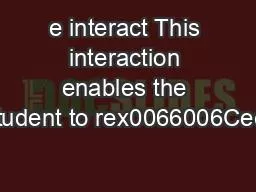

Cultureson cultural patterns and consequently gain insight into their own language and culture Through the study of the target language students examine the relationship amongst products practices and ID: 899675
Download Pdf The PPT/PDF document "e interact This interaction enables the ..." is the property of its rightful owner. Permission is granted to download and print the materials on this web site for personal, non-commercial use only, and to display it on your personal computer provided you do not modify the materials and that you retain all copyright notices contained in the materials. By downloading content from our website, you accept the terms of this agreement.
1 Cultures e interact. This interaction en
Cultures e interact. This interaction enables the student to re�ect on cultural patterns and consequently, gain insight into their own language and culture. Through the study of the target language, students examine the relationship amongst products, practices, and perspectives of the culture studied, thus empowering them to engage in direct interaction with members of other cultures. Culture re�ects the philosophical perspectives, the behavioral practices, and the products (both tangible and intangible) of a society. Culture may be understood to include three aspects of a society: Practices are patterns of socially accepted behavior and deal with aspects of culture (e.g., rites of passage, forms of discourse, social “pecking order,” and use of space). Products are required or justi�ed by the underlying beliefs and values of the culture studied. Products may be tangible (e.g., a painting, a piece of literature, a statue, etc.) or intangible (e.g., an oral tale, a dance, a sacred ritual). Perspectives are also justi�ed by the underlying beliefs and values of the culture studied. Perspectives are intangible (e.g., Relating Cultural Practices to Perspectives: Learners use the language to investigate, explain, and re�ect on the relationship between the practices and perspectives of the cultures studied. Relating Cultural Products to Perspectives: Learners use the language to investigate, explain, and re�ect on the relationship between the products and perspectives of the cultures studied. Interact with cultural competence and understanding. STANDARDS GOAL Connecting with other disciplines generates learning through additional bodies of knowledge provided by language learning that is not available to monolingual English speakers. Concepts presented in other disciplines are the basis for continued learning in the world language class. Language used in this manner helps students integrate what they have learned in other content areas with the material they learn in the target language. This holistic system shifts from teacher-directed to student-directed learning since the students use their developing language skills to go beyond the classroom setting and become life-long language learners. By working Across Disciplines, students reinforce and further their knowledge of multiple disciplines through the world language. Through Added Perspective
2 s, language learners broaden the source
s, language learners broaden the sources of information available to them. Making Connections: Learners build, reinforce, and expand their knowledge of other disciplines while using the language to develop critical thinking and to solve problems creatively. Acquiring Information and Diverse Perspectives: Learners access and evaluate information and diverse perspectives that are available through the language and its cultures. Connect with other areas’ disciplines and acquire information and diverse perspectives in order to use the language to function in academic and career-related situations. STANDARDS GOAL Connections Comparing different languages and cultures develops a broader worldview. Learning the linguistic elements in the new Language impacts the students’ abilities to examine their own language and to develop hypotheses about the structure and use of languages. Cultures through language learning, they continually discover perspectives, practices, and products that are similar to and different from those in their own cultures. Language Comparisons: Learners use the language to investigate, explain, and re�ect on the nature of language through comparisons of the language studied and their own. Cultural Comparisons: Learners use the language to investigate, explain, and re�ect on the concept of culture through comparisons of the cultures studied and their own. Develop insight into the nature of language and culture in order to interact with cultural competence. The use of the foreign language in the community and familiarity with the products and practices of the target culture foster cross- cultural understanding and enrich the community. Students come to realize the Practical Applications inherent in knowing other languages as a tool for communication. Personal Enrichment by accessing various entertainment and information sources available to speakers of other languages. School and Global Communities: Learners use the language both within and beyond the classroom to interact and collaborate in their community and the globalized world. Lifelong Learning: Learners set goals and re�ect on their progress in using languages for enjoyment, enrichment, and advancement. Communicate and interact with cultural competence in order to participate in multilingual communities or at home and around the world. Comparisons STANDARDS GOAL STANDARDS GOAL Communitie